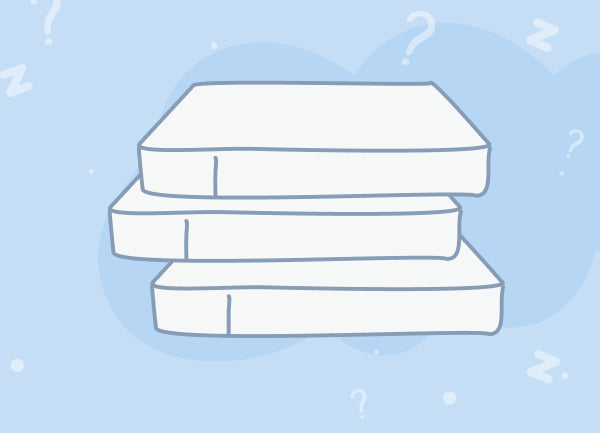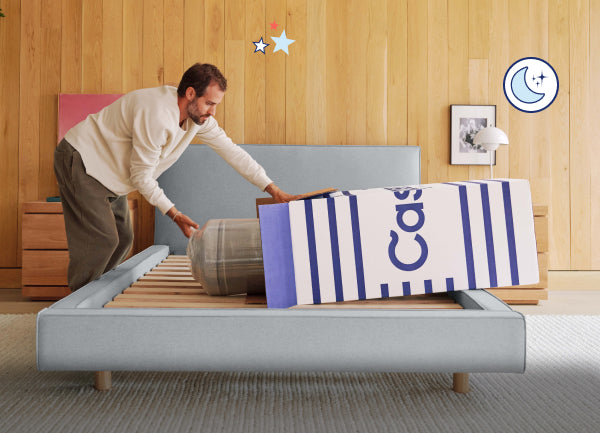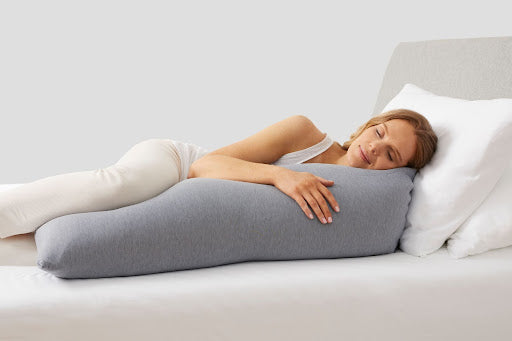Is your bed in need of a serious makeover? A plush, stylish duvet might be just what you need. Before you start shopping, though, you’ll need to know which duvet sizes to look for.
What is a duvet, you may ask? A duvet is a quilted blanket that goes inside a protective duvet cover. It tops off your bed and spills neatly over the sides of your mattress. However, it’s important to find a duvet size that matches your mattress size to get the look just right.
In this guide, we’ll go through the different duvet and cover dimensions, give you pointers on what to look for, and answer frequently asked duvet questions.
To get started, check out our duvet cover size chart below. Keep in mind that these sizes will differ from brand to brand.
| Mattress Size | Duvet + Cover Size (in) | Duvet + Cover Size (cm) |
|---|---|---|
| Twin | 74 x 98 | 188 x 249 |
| Twin XL | 74 x 98 | 188 x 249 |
| Full | 95 x 98 | 241 x 249 |
| Queen | 95 x 98 | 241 x 249 |
| King | 111 x 98 | 282 x 249 |
| California King | 111 x 98 | 282 x 249 |
Duvet Cover Sizes
Here, we’ll go a little more in-depth into the different duvet and duvet cover sizes for each bed type. Read on to find the ideal size for each and every bed.

Twin Duvet Size
Twin-sized duvets can start as small as 64” x 88” but differ from brand to brand. A Casper twin mattress is 38” x 75”, requires flat twin sheets that are 75” x 102”, and needs a duvet size of 74” x 98”.
Size: 74” x 98” | 188 x 249 cm
Twin XL Duvet Size
Twin XL mattresses are five inches longer than twins. However, they’re identical in width — so a twin-sized duvet should fit both.
Size: 74” x 98” | 188 x 249 cm
Full Duvet Size
A full-sized bed with a duvet is not too small, not too large: a popular option for a guest bedroom. Full-size duvets range in dimensions, but they should measure around 95” x 98”. A full Casper mattress is 53” x 75”, and requires full flat sheets that are 96″ x 102″.
Size: 95” x 98” | 241 x 249 cm
Queen Duvet Size
A queen bed is another solid choice for a guest bedroom or primary bedroom. Our queen duvet cover dimensions are the same as our full duvets, measuring 95” x 98”. However, queen-size sheets are a little bit larger.
Size: 95” x 98” | 241 x 249 cm
King Duvet Size
A classic primary bedroom choice, king beds look extra luxe with a plush duvet on top. Our king duvets are 111” x 98”. Make sure to look for king-sized sheets that measure 112″ x 102″ to complete the look.
Size: 111” x 98” | 282 x 249 cm
California King Duvet Size
If you need a duvet for your spacious California king, no need to look far. Our king-size duvets will fit a California king mattress, too.
Size: 111” x 98” | 282 x 249 cm
What To Look For in a Duvet and Cover
Now that you know which duvet size to get, you can focus on what it’s made of. With so many duvets out there to choose from, picking one can seem overwhelming. However, we’ve narrowed down the three most important things to look for in a duvet and cover.

Cover Fabric
Duvet shells are typically made from cotton, but they also come in flannel, silk, bamboo, and polyester. Here’s an overview of each.
- Cotton: Egyptian cotton is a breathable choice with soft fibers. Supima cotton is a higher-quality, more expensive cotton that is very durable.
- Silk: Produced by silkworms, silk is a natural fiber that is smooth, soft, and airy. However, they can be a little more expensive and difficult to clean.
- Bamboo fibers: This sustainable, organic option is hypoallergenic and soft on those with sensitive skin.
- Flannel: Flannel is a mixture of cotton and wool that keeps you warm at night.
- Polyester: A human-made synthetic fiber, polyester is a budget-friendly option that is easy to clean.
For all the hot sleepers out there who want to doze without a sweat, we made our down alternative duvet’s shell with 100% TENCEL® Lyocell — a highly breathable, durable fiber made from sustainably sourced wood pulp.
Fill
A duvet insert is stuffed with filling to keep it plush and fluffy. There are different types of inside fill for duvets, and the best one all depends on your priorities. Here’s an overview of the most common fillings:
- Down: Down feathers are sourced from the insulating undercoat of waterfowl, making them especially soft and cozy. Casper’s down duvets are made with ethically sourced down for all-natural comfort you can feel good about.
- Feathers: Feathers are sourced from birds’ exterior, so they are more rigid and bulkier than down. However, they provide a lighter feeling in a duvet.
- Wool: Wool filling is hypoallergenic and water-resistant. We made our humidity fighting duvet with a layer of merino wool to wick away moisture and keep you from sleeping too hot.
- Synthetic polyester: Synthetic polyester is a down alternative that imitates down’s plush softness. When considering down vs. down alternative, this is a good option for those who are allergic to down or want a machine-washable option. Our down alternative duvet is made with a soft fiber fill that has the fluffy comfort of down, but is actually recycled polyester made from water bottles.
You’ll need to consider the material that will keep you most comfortable at night. Heavier materials like down will keep you warm. However, if you sleep hot, you might want to opt for a lightweight duvet instead. All of our duvets come in both midweight and lightweight options to accommodate every type of sleeper.
Thread Count
Thread count is the threads per square inch of a material. A higher thread count indicates a softer, breathable fabric, while a lower thread count can be more cost-effective.
A duvet cover should have a thread count of 200 to 600. The exact number depends on your preferences, but a cover in this range should be reasonably soft and durable. Anything lower runs the risk of the fill leaking through.
FAQs
Still have lingering duvet questions? To make sure you’re 100% confident when shopping for your new bedding, we’ll answer some of the most frequently asked questions below.
Duvet sizes differ across brands, so it’s best to measure your bed and pay attention to the dimensions on each duvet you’re considering. Find a duvet size that corresponds to your mattress size.
Yes. If you have a duvet, we recommend using a duvet cover. Think of the duvet cover like a big pillowcase for the duvet insert. The cover protects the duvet insert from dirt and sweat. Plus, since it’s removable, the cover makes everything super easy to clean.
If you have a comforter, you don’t need a duvet cover. However, some people opt to put a duvet cover over a comforter to keep it clean over time.
Often, duvet inserts are designed to be several inches longer than the duvet cover. This helps create a fluffier look once you put the duvet inside the cover. However, always make sure to check the dimensions on both. Either get a duvet cover that is the same size as the insert or around two inches shorter.
When it comes to full vs queen beds, there are quite a few similarities. Casper full and queen-sized duvets are the same size. However, different brands may have different designated sizes for full and queen mattresses.
A duvet includes two pieces: a cover and an insert. A comforter is just one piece of quilted bedding.
So, duvet vs. comforter: Which one is best? A duvet is easy to care for and gives your bed a fluffy, clean look. However, it requires some assembly to correctly place the insert inside the cover. A quilt or comforter is ready to go right away and creates a more layered look on your bed. However, a quilt can be hotter at night and more difficult to clean.
The fill weight refers to how many ounces of down are inside a duvet.
The fill weight goes hand-in-hand with the fill power, or the amount of space occupied by one ounce of down. The higher the fill power, the higher quality the down and the warmer the duvet. The Casper Down Duvet has a fill power of 600 cubic inches and the Humidity Fighting Duvet has a fill power of 750 cubic inches.
Yes, you can machine wash a duvet. Check out the care instructions on your duvet’s label first, though, as some might have special instructions or suggest professional cleaning.
When washing a duvet, make sure to remove the duvet cover. Use an extra-large capacity washer and dryer if you’re washing a king- or queen-sized duvet.
With these tips, you’ll find the perfect duvet in no time. At Casper, our duvets are designed with the fluff dreams are made of.
If you found this guide helpful, check out our bed sheet size guide and pillow size guide to find all the correct-sized bedding you’ll ever need and start snoozing in style.














